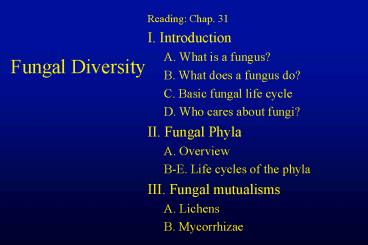Fungal Diversity - PowerPoint PPT Presentation
1 / 38
Title:
Fungal Diversity
Description:
Same material that is in the external skeletons of arthropods - insects, ... b. winter food for caribou and reindeer in Arctic. A. Lichens. 4. Importance ... – PowerPoint PPT presentation
Number of Views:1803
Avg rating:3.0/5.0
Title: Fungal Diversity
1
Fungal Diversity
- Reading Chap. 31
- I. Introduction
- A. What is a fungus?
- B. What does a fungus do?
- C. Basic fungal life cycle
- D. Who cares about fungi?
- II. Fungal Phyla
- A. Overview
- B-E. Life cycles of the phyla
- III. Fungal mutualisms
- A. Lichens
- B. Mycorrhizae
2
A. What is a fungus?
- The humongous fungus
3
A. What is a fungus?
- The parts
Fig. 31.1
Cell walls - made of chitin. Same material that
is in the external skeletons of arthropods -
insects, arachnids, and crustaceans.
4
A. What is a fungus?
- Also yeasts - single-celled
- e.g., Saccharomyces cerevisiae
- Candida albicans
31.15
5
B. What does a fungus do?
- Absorptive heterotroph
- Such as
6
Also eat - wood in houses, boats, fences -
food - other materials - cloth, paint, leather,
waxes, jet fuel, petroleum, paper, wire
insulation, photographic film, - to name a few.
What do all of these materials have in common?
They are all C-based.
7
C. Basic fungal life cycle
1. Zygotic - haploid phase is dominant
fig. 13.5b
8
C. Basic fungal life cycle
2. Fertilization doesnt happen all at once
Plasmogamy - fusion of cytoplasm Karyogamy -
fusion of nuclei (gametes) heterokaryotic dikaryo
tic
fig. 31.2
9
C. Basic fungal life cycle
3. Usually not identifiable male and female
individuals
draw
10
D. Who cares about fungi?
- 1. Decomposers
11
D.2. Agricultural pests
ergot
Stem rust
Pink ear rot
Parasites
Food spoilage
12
D.3. Food - morels, truffles, shitakes, common
button mushrooms
13
D.4. Medicinals
- Penicillium, etc.
- and hallucinogens
- - Psilocybin
- - ergot (LSD)
14
D.5. Yeast for brewing and baking Saccharomyces
cerevisiae
15
II. Fungal Phyla
- A. Overview
- 1. Common eukaryotic ancestor with animals
fig. 28.8
16
II. Fungal Phyla
- A. Overview
- 2. Four phyla of fungi
fig. 31.4
17
B. Zygomycota
- 1. No dikaryotic growth
- 2. Both sexual and asexual sporangia
18
B. Zygomycota
- 3. Examples
- - Rhizopus (fig. 31.6)
31.8
Pilobolus
Many endomycorrhizae, too (e.g., Glomus)
19
C. Ascomycota sac fungi or cup fungi
Scarlet cup
Morels
Truffles
Many lichen fungi too!
20
C. Ascomycota - Life cycle
1. Dikaryotic growth 2. Fruiting body
ascocarp 3. Fertile layer with asci 4. Eight
ascospores per ascus (sac) 5. Asexual
reproduction via conidia
21
D. Basidiomycota - club fungi
Hygrophorus
Shelf or bracket fungus
31.11
Stinkhorn fungus
Many mushrooms are ectomycorrhizal.
22
D. Basidiomycota - Life cycle
1. Dikaryotic growth 2. Fruiting body
basidiocarp 3. Fertile layer on gills with
basidia (clubs) 4. Four spores per
basidium 5. Asexual reproduction is rare
23
D. Basidiomycota - structure
2. Fruiting body basidiocarp 3. Fertile layer on
gills with basidia (clubs) 4. Four spores
per basidium
24
E. Deuteromycota - fungi imperfecti
- 1. Not a true phylum (not a natural group)
polyphyletic - 2. Fungi with no known sexual reproduction
- 3. Asexual reproduction by conidia
25
III. Fungal mutualisms
Definitions Symbiosis - 2 organisms living
together in intimate physical contact Mutualism
- both organisms benefit from the
relationship Parasitism - one benefits, one
loses Commensalism - one benefits, other not
affected
26
III. Fungal mutualisms
- Questions
- 1. Definition of mutualism vs. symbiosis
- 2. What fungal and photosynthetic partners are
involved? - 3. What is the currency of the mutualism? How
do the partners benefit? - 4. What is the structure and/or morphology of the
organismal interaction? - 5. What is the ecological importance?
27
A. Lichens
1. Partners a. Fungal partner - gives
protection - mostly Ascomycetes (25,000
spp.) - only found in lichens (not
free-living) b. Photosynthetic partner -
gives fixed carbon (sugars) - green alga or
cyanobacterium - can be free-living
28
A. Lichens
a. most of lichen body is fungal hyphae b.
photosynthetic partner in a distinct layer c.
sexual reproduction of fungal partner only d.
asexual reproduction soredia, fragmentation
2. Anatomy
medulla
29
A. Lichens
3. Morphology
30
A. Lichens
- 4. Importance
- a. rock weathering, soil formation in primary
succession - - acid secretion
- - trapping particulates
- - nitrogen fixation (cyanobacteria)
31
A. Lichens
- 4. Importance
- b. winter food for caribou and reindeer in Arctic
32
A. Lichens
- 4. Importance
- c. Indicators susceptible to pollutants
33
B. Mycorrhizae
- mycor fungus, rhizae root
- 1. Partners
- a. Fungus
- - gets fixed carbon (sugars)
- - both Zygomycetes and Basidiomycetes (a few
Ascos) - - relatively few Zygos not plant species
specific - - many Basidios fairly plant species specific
34
B. Mycorrhizae
- 1. Partners
- b. Plant
- - gets nutrients (mostly P) and water
- - about 80 of all plant species are mycorrhizal!!
35
B. Mycorrhizae
- 2. Structure two types of fungal/plant contact
- a. external (ectomycorrhizae)
- - fungal sheath around root
- - Basidiomycetes and about
- 5000 plant species (mostly woody)
Smith 1999
Fig. 31.18
36
B. Mycorrhizae
- 2. Structure two types of fungal/plant contact
- b. internal (endomycorrhizae)
- - hyphae penetrate root cells
- - Zygomycetes
- - 80 of all plants (many herbaceous)
Smith 1999
37
B. Mycorrhizae
- 2. Structure fungal mycelium
- - dramatic increase in root surface area
- 10,0001
Raven et al. 1999
38
B. Mycorrhizae
No mycorrhizae
With mycorrhizae
- 3. Benefits - is it worth it?
No mycorrhizae
With mycorrhizae
Fig. 31.19































